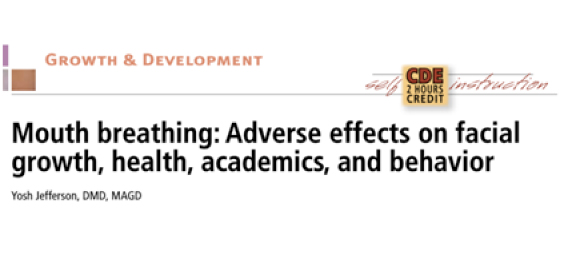30 years of physiological research points to many symptoms triggered, caused or exacerbated by dysfunctional breathing. Several papers outlining the implications of hypocapnia, the condition caused by over-breathing, are listed and linked in the white paper section below. The specific symptoms that show up in an individual will be a function of genetics, physiological health (respiratory fitness being a key marker of that health), the extent of over-breathing and other contributing factors (i.e. nutrition, inflammation toxins, hydration, mineral deficiencies, etc). To move away from symptoms and toward optimal health a good place to start is with assessment and education (for a deeper dive into habits that will dramatically give health a boost, see betterbeingproject.org). The second step is ensuring that behaviors or triggers that create the conditions and health risks are removed…. especially those that cause inflammation. For example cigarette smoke, pet dander, toxins, foods or drinks all can cause an allergenic or inflammatory response that should be avoided or removed as soon as detected. The third is building more robust physiology and mental balance to shield against dips in these other variables and keep your vehicle (you) running smoothly for many many years.
STRESS AND SYMPTOMS
POOR BREATHING AND SYMPTOMS
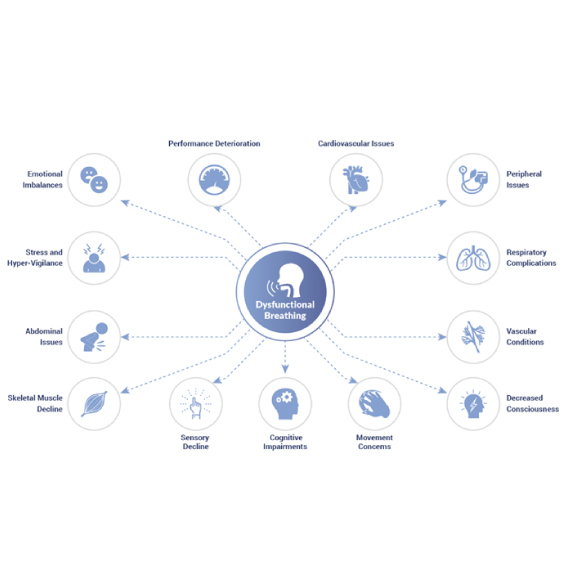
POOR BREATHING AND SYMPTOMS
30 years of physiological research points to many symptoms triggered, caused or exacerbated by dysfunctional breathing. Several papers outlining the implications of hypocapnia, the condition caused by over-breathing, are listed and linked in the white paper section below. The specific symptoms that show up in an individual will be a function of genetics, physiological health (respiratory fitness being a key marker of that health), the extent of over-breathing and other contributing factors (i.e. nutrition, inflammation toxins, hydration, mineral deficiencies, etc). To move away from symptoms and toward optimal health a good place to start is with assessment and education (for a deeper dive into habits that will dramatically give health a boost, see betterbeingproject.org). The second step is ensuring that behaviors or triggers that create the conditions and health risks are removed…. especially those that cause inflammation. For example cigarette smoke, pet dander, toxins, foods or drinks all can cause an allergenic or inflammatory response that should be avoided or removed as soon as detected. The third is building more robust physiology and mental balance to shield against dips in these other variables and keep your vehicle (you) running smoothly for many many years.


Acute fatigue
Chronic fatigue
Weakness
Headache
Burnout
Anxiety
Muscle PainAnxiety
Anger
Fear
Panic
Phobia
Worry
Crying
Bad Mood
Frustation
Apprehension
Performance AnxietyAttention deficit
Disorientation
Poor memory
Learning deficits
Confusion
Brain fogBlurred vision
Dishabituation
Sound seems distant
Reduced pain threshold
Dry mouth
Tinnitus
Numbness
Tinglig
Dry skinNausea
Cramping
BloatingSleep Apnea
Anxiety
Rehearsal
Focus
Endurance
Altitude sickness
Fatigue
PainPalpitations
Increased heart rate
Angina symptoms
Arrhythmias
Nonspecific pain
ECG abnormalitiesHypertension
Migraine
Tissue Anemia
Thrombosis
Compromised
placental Blood FlowTrembling
Twitching
Shivering
Sweatiness
Coldness
Tinglig
NumbnessEye-hand coordination
Perceptual judgment
Coordination
Reaction time
Balance
Tetany
Hyperreflexia
Spasm
Fatigue
Pain
Challenged SwallowShortness of breath
Bronchial constriction/spasm
Airway resistance
Asthma symptoms
Chest tightness/pressure/pain
Inflammation exacerbation
Reduce Lung ComplianceDizziness
Loss of balance
Fainting
Black out
Confusion
Disorientation
Hallucinations
Traumatic memories
Low self-esteem
Personality shifts
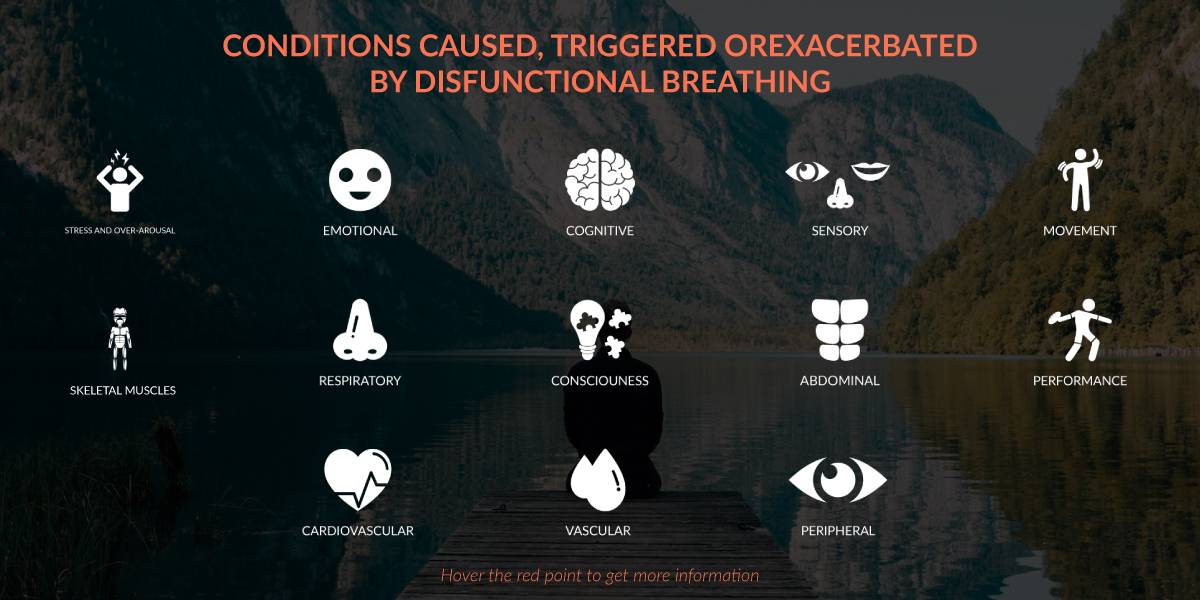
Acute fatigue
Chronic fatigue
Weakness
Headache
Burnout
Anxiety
Muscle PainAnxiety
Anger
Fear
Panic
Phobia
Worry
Crying
Bad Mood
Frustration
Apprehension
Performance AnxietyAttention deficit
Disorientation
Poor memory
Learning deficits
Confusion
Brain fogBlurred vision
Dishabituation
Sound seems distant
Reduced pain threshold
Dry mouth
Tinnitus
Numbness
Tingling
Dry SkinNausea
Cramping
BloatingSleep Apnea
Anxiety
Rehearsal
Focus
Endurance
Altitude sickness
Fatigue
PainPalpitations
Increased heart rate
Angina symptoms
Arrhythmias
Nonspecific pain
ECG abnormalitiesHypertension
Migraine
Tissue Anemia
Thrombosis
Compromised placental Blood FlowTrembling
Twitching
Shivering
Sweatiness
Coldness
Tingling
NumbnessEye-hand coordination
Perceptual judgment
Coordination
Reaction time
BalanceTetany
Hyperreflexia
Spasm
Weakness
Fatigue
Pain
Challenged SwallowShortness of breath
Bronchial constriction / spasm
Airway resistance
Asthma symptoms
Chest tightness / pressure / pain
Inflammation exacerbation
Reduced Lung ComplianceDizziness
Loss of balance
Fainting
Black-out
Confusion
Disorientation
Disconnectedness
Hallucinations
Traumatic memories
Low-self-esteem
Personality shifts
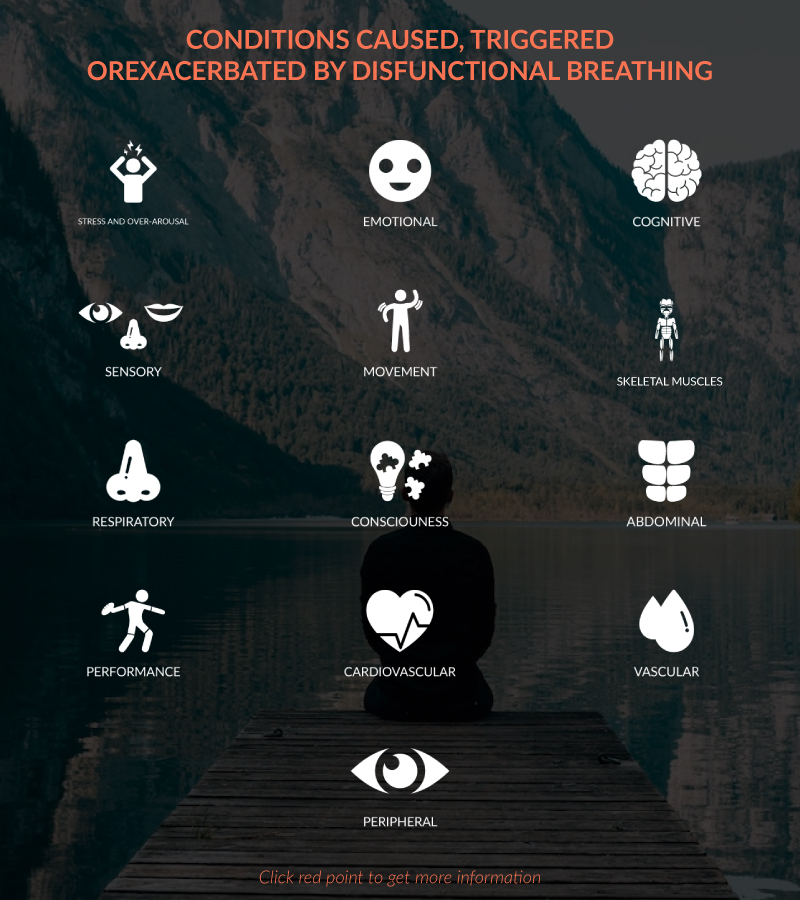
Acute fatigue
Chronic fatigue
Weakness
Headache
Burnout
Anxiety
Muscle PainAnxiety
Anger
Fear
Panic
Phobia
Worry
Crying
Bad Mood
Frustation
Apprehension
Performance AnxietyAttention deficit
Disorientation
Poor memory
Learning deficits
Confusion
Brain fogBlurred vision
Dishabituation
Sound seems distant
Reduced pain threshold
Dry mouth
Tinnitus
Numbness
Tinglig
Dry skinEye-hand coordination
Perceptual judgment
Coordination
Reaction time
BalanceTetany
Hyperreflexia
Spasm
Fatigue
Pain
Challenged SwallowShortness of breath
Bronchial constriction/spasm
Airway resistance
Asthma symptoms
Chest tightness/pressure/pain
Inflammation exacerbation
Reduce Lung ComplianceDizziness
Loss of balance
Fainting
Black out
Confusion
Disorientation
Hallucinations
Traumatic memories
Low self-esteem
Personality shiftsNausea
Cramping
BloatingSleep Apnea
Anxiety
Rehearsal
Focus
Endurance
Altitude sickness
Fatigue
PainPalpitations
Increased heart rate
Angina symptoms
Arrhythmias
Nonspecific pain
ECG abnormalitiesHypertension
Migraine
Tissue Anemia
Thrombosis
Compromised
placental Blood FlowTrembling
Twitching
Shivering
Sweatiness
Coldness
Tinglig
Numbness
Responses to the questionnaire below (downloadable by clicking on this link) will provide a better idea of whether life can be improved through breathing modification. Place a 0, 1 or 2 next to each item below with regard to severity or frequency (1 being occasionally; 2 is often). Double the score for those answers in italics and add up your score.

Scoring:
18 or more: Your current breathing patterns appear to be stressing out your physiology. Health, performance and well-being (H, P & WB) have been compromised. Confirm by running a quick RF test. Can you comfortably hold your breath for at least 10 to 15 seconds after a normal ½ exhale? Do not take a larger than normal inhale prior to this exercise. Stop timing at the first urge to breathe. If RF is under 15 seconds, habit change (RF training and additional Better Being practices) should be a priority to improve health and performance. If diagnosed with a formal condition, consult with your doctor prior to undertaking RF training. If RF is 15 seconds or more and this level of symptoms are present, consider an in-person or web-based consultation with breathing.coach to improve RF.
11 – 17: There is a high probability that your current breathing is deteriorating H, P & WB. This can be confirmed by a capnometry assessment or the RF test. RF training and Better Being practices are highly recommended.
2 – 10: Depending on symptoms, your breathing may be compromising H, P & WB. A capnometry assessment or the RF test will confirm your level of respiratory fitness and whether sub-par breathing and poor CO2 adaptation are stressing internal chemistry and physiology. If your respiratory fitness level is above 30, consider advanced RF training and Better Being practices to move from healthy to bulletproof.
Note: Capnotraining, RF training and Better Being practices are not treatments. They are guidance and training toward behaviours that will move health and performance in the right direction.
Responses to the questionnaire below (downloadable by clicking on this link) will provide a better idea of whether life can be improved through breathing modification. Place a 0, 1 or 2 next to each item below with regard to severity or frequency (1 being occasionally; 2 is often). Double the score for those answers in italics and add up your score.
Scoring:
18 or more: Your current breathing patterns appear to be stressing out your physiology. Health, performance and well-being (H, P & WB) have been compromised. Confirm by running a quick RF test. Can you comfortably hold your breath for at least 10 to 15 seconds after a normal ½ exhale? Do not take a larger than normal inhale prior to this exercise. Stop timing at the first urge to breathe. If RF is under 15 seconds, habit change (RF training and additional Better Being practices) should be a priority to improve health and performance. If diagnosed with a formal condition, consult with your doctor prior to undertaking RF training. If RF is 15 seconds or more and this level of symptoms are present, consider an in-person or web-based consultation with breathing.coach to improve RF.
11 – 17: There is a high probability that your current breathing is deteriorating H, P & WB. This can be confirmed by a capnometry assessment or the RF test. RF training and Better Being practices are highly recommended.
2 – 10: Depending on symptoms, your breathing may be compromising H, P & WB. A capnometry assessment or the RF test will confirm your level of respiratory fitness and whether sub-par breathing and poor CO2 adaptation are stressing internal chemistry and physiology. If your respiratory fitness level is above 30, consider advanced RF training and Better Being practices to move from healthy to bulletproof.
Note: Capnotraining, RF training and Better Being practices are not treatments. They are guidance and training toward behaviours that will move health and performance in the right direction.

BRONCHIAL
CONSTRICTION
From a physiological standpoint, unbalanced pH and low 2 brought on by over-breathing or environmental triggers (e.g. allergies) result in vasoconstriction of the smooth muscles in the airways. In susceptible individuals, this leads to bronchial constriction/asthma making it more difficult to breathe. To compound matters, shortage of air can create a psychological component (i.e. anxiety) resulting in further over-breathing and an increased heart-rate –in spite of airway restriction. Capnometry has been researched as one means of reducing asthma-related symptoms. Beyond Capnometry training, RF training renormalizes breathing and builds a more robust buffer system so that pH imbalances and vasoconstriction do not occur as readily when environmental or mental triggers are present. As an asthmatic myself back in the day (author of website speaking now), it took a number of lifestyle and habit changes to eradicate all asthmatic and sinus congestion/inflammatory symptoms. Changing my breathing habit was a big part of the solution… especially for exercise induced asthma. I am happy to share more details and ideas in a consultation session.
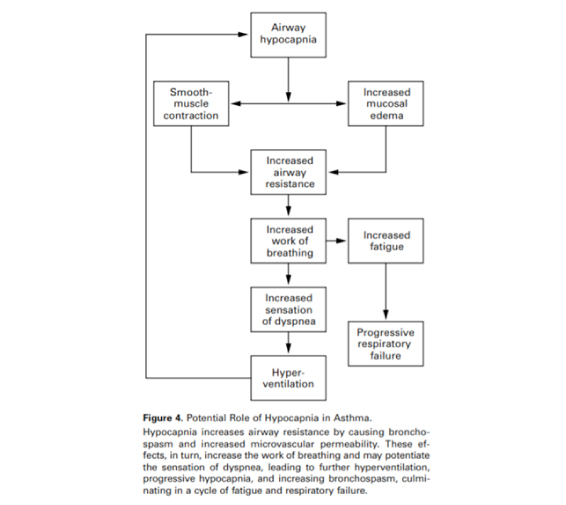
Treatment suggested toward the end of this research paper:
“The intervention most commonly used for breathing pattern disorders is breathing retraining exercises. Pediatric studies are limited to reports of case series (51), but a large adult clinical trial in which asthmatics were taught by a trained physiotherapist or used a self-help online programme reported significant improvements in quality of life scores compared to placebo (52). A smaller randomized controlled trial also reported positive results (53). A number of adult studies evaluating yoga and including yoga breathing techniques have shown small improvements in quality of life in unselected populations of asthmatics (54)”
Yoga therapy is risky as many yoga practices advocate deep breathing which can exacerbate asthmatic symptoms. Those referred to in this article are likely very specific practices that may offer partial results of Respiratory Fitness Training.
BRONCHIAL
CONSTRICTION
From a physiological standpoint, unbalanced pH and low 2 brought on by over-breathing or environmental triggers (e.g. allergies) result in vasoconstriction of the smooth muscles in the airways. In susceptible individuals, this leads to bronchial constriction/asthma making it more difficult to breathe. To compound matters, shortage of air can create a psychological component (i.e. anxiety) resulting in further over-breathing and an increased heart-rate –in spite of airway restriction. Capnometry has been researched as one means of reducing asthma-related symptoms. Beyond Capnometry training, RF training renormalizes breathing and builds a more robust buffer system so that pH imbalances and vasoconstriction do not occur as readily when environmental or mental triggers are present. As an asthmatic myself back in the day (author of website speaking now), it took a number of lifestyle and habit changes to eradicate all asthmatic and sinus congestion/inflammatory symptoms. Changing my breathing habit was a big part of the solution… especially for exercise induced asthma. I am happy to share more details and ideas in a consultation session.

Treatment suggested toward the end of this research paper:
“The intervention most commonly used for breathing pattern disorders is breathing retraining exercises. Pediatric studies are limited to reports of case series (51), but a large adult clinical trial in which asthmatics were taught by a trained physiotherapist or used a self-help online programme reported significant improvements in quality of life scores compared to placebo (52). A smaller randomized controlled trial also reported positive results (53). A number of adult studies evaluating yoga and including yoga breathing techniques have shown small improvements in quality of life in unselected populations of asthmatics (54)”
Yoga therapy is risky as many yoga practices advocate deep breathing which can exacerbate asthmatic symptoms. Those referred to in this article are likely very specific practices that may offer partial results of Respiratory Fitness Training.

SYMPTOM
CORRELATIONS
There appears to be a common thread between asthma, anxiety, and panic (see Katon Research Article 2004). Unbalanced physiology could certainly contribute to the correlation. Lack of 2 adaptation/respiratory fitness moves the bicarbonate buffer system toward the edge of the buffer zone (see FAQ’s). Small changes in the external or internal environment –including one’s 2 level itself in the case of panic attacks according to research — now send physiology beyond limits where symptom flares arise. These symptoms can be in the form of anxiety, panic, asthma or combination thereof. Unfortunately, this can, in turn, can create more stress and dysfunctional breathing — potentially creating a vicious cycle where both the mind and the nervous system are triggered toward suffering. Episodic events – whether it be anxiety or an asthma attack –are challenging to escape without proper coping skills or medications. One solution is to avoid all triggers. This option presents its challenges unless one is living in a bubble and has a settled mind. A second is to always have rescue medications on hand or take preventative medication to keep symptoms under control. This strategy has its own long-term health implications and associated costs. A third is to train underlying physiology and mental balance into a more robust state. See Technologies and Services for more information on Better Being Training when ready for this more holistic approach.
SYMPTOM
CORRELATIONS
There appears to be a common thread between asthma, anxiety, and panic (see Katon Research Article 2004). Unbalanced physiology could certainly contribute to the correlation. Lack of 2 adaptation/respiratory fitness moves the bicarbonate buffer system toward the edge of the buffer zone (see FAQ’s). Small changes in the external or internal environment –including one’s 2 level itself in the case of panic attacks according to research — now send physiology beyond limits where symptom flares arise. These symptoms can be in the form of anxiety, panic, asthma or combination thereof. Unfortunately, this can, in turn, can create more stress and dysfunctional breathing — potentially creating a vicious cycle where both the mind and the nervous system are triggered toward suffering. Episodic events – whether it be anxiety or an asthma attack –are challenging to escape without proper coping skills or medications. One solution is to avoid all triggers. This option presents its challenges unless one is living in a bubble and has a settled mind. A second is to always have rescue medications on hand or take preventative medication to keep symptoms under control. This strategy has its own long-term health implications and associated costs. A third is to train underlying physiology and mental balance into a more robust state. See Technologies and Services for more information on Better Being Training when ready for this more holistic approach.



SLEEP
ISSUES
Part of the problem is that there is no one thing called sleep and there is no one thing called a sleep disorder. The kind of disorders treated at a sleep clinic, namely the assessment and management of sleep apnea probably don’t respond well to behavioral interventions of any sort including neurofeedback. That is typically about 5% of the cases. Most of the other 95% involve sleep onset which is commonly but poorly treated by medications because virtually every medication that helps us get sleepy also disrupts 1 or more phases of sleep (that is the 4 stages of non-REM sleep plus REM sleep). Neurofeedback, especially Alpha up training or Alpha and Theta Up training have a long history of jury-journal research establishing that these protocols foster relaxation to include reduced muscle tension, reduced sympathetic arousal and cortical disengagement from processing sensory stimulation and emotional stimulation (essentially because a normal brain in and eyes-closed rest condition spontaneously generates large posterior alpha waves initially until moving into stage 1 sleep, wherein Posterior Theta becomes conspicuous).
What many physicians don’t know is that since the mid-1960’s. Neurofeedback has established that it can train brain wave patterns towards normalcy in the case of insufficient Alpha or Theta. Hence this kind of intervention could be great for reducing sleep onset time. Another significant class of sleep disorders involves sleep fragmentation, wherein a person may have no difficulty getting to sleep, but wakes frequently due to sleep fragmentation rather than apnea. When sleep fragmentation is an issue, in many cases due to dysregulated breathing or trips to the bathroom, modifying behavior through breathing retraining and development of respiratory fitness… as well as sleep positioning can be most helpful to wakefulness in the night. Your breathing coach can assist with all of this and can in some cases assist with apnea as well.
Jerry R. DeVore, PhD, ABPP, BCB, BCN
Clinical Psychologist
SLEEP
ISSUES
Part of the problem is that there is no one thing called sleep and there is no one thing called a sleep disorder. The kind of disorders treated at a sleep clinic, namely the assessment and management of sleep apnea probably don’t respond well to behavioral interventions of any sort including neurofeedback. That is typically about 5% of the cases. Most of the other 95% involve sleep onset which is commonly but poorly treated by medications because virtually every medication that helps us get sleepy also disrupts 1 or more phases of sleep (that is the 4 stages of non-REM sleep plus REM sleep). Neurofeedback, especially Alpha up training or Alpha and Theta Up training have a long history of jury-journal research establishing that these protocols foster relaxation to include reduced muscle tension, reduced sympathetic arousal and cortical disengagement from processing sensory stimulation and emotional stimulation (essentially because a normal brain in and eyes-closed rest condition spontaneously generates large posterior alpha waves initially until moving into stage 1 sleep, wherein Posterior Theta becomes conspicuous).

What many physicians don’t know is that since the mid-1960’s. Neurofeedback has established that it can train brain wave patterns towards normalcy in the case of insufficient Alpha or Theta. Hence this kind of intervention could be great for reducing sleep onset time. Another significant class of sleep disorders involves sleep fragmentation, wherein a person may have no difficulty getting to sleep, but wakes frequently due to sleep fragmentation rather than apnea. When sleep fragmentation is an issue, in many cases due to dysregulated breathing or trips to the bathroom, modifying behavior through breathing retraining and development of respiratory fitness… as well as sleep positioning can be most helpful to wakefulness in the night. Your breathing coach can assist with all of this and can in some cases assist with apnea as well.
Jerry R. DeVore, PhD, ABPP, BCB, BCN
Clinical Psychologist
ADDITIONAL STUDIES
& WHITE PAPERS

ADDITIONAL STUDIES
& WHITE PAPERS


HYPOCAPNIA
The following papers provide insight into the many complications associated with over-breathing/Hypocapnia
Resources
Hypocapnia Overview – Medical Progress in the New England Journal of Medicine
Discussion Paper: Breathing pattern disorders and physiotherapy: inspiration for our profession
HYPOCAPNIA
The following papers provide insight into the many complications associated with over-breathing/Hypocapnia
Resources
Hypocapnia Overview – Medical Progress in the New England Journal of Medicine
Discussion Paper: Breathing pattern disorders and physiotherapy: inspiration for our profession



